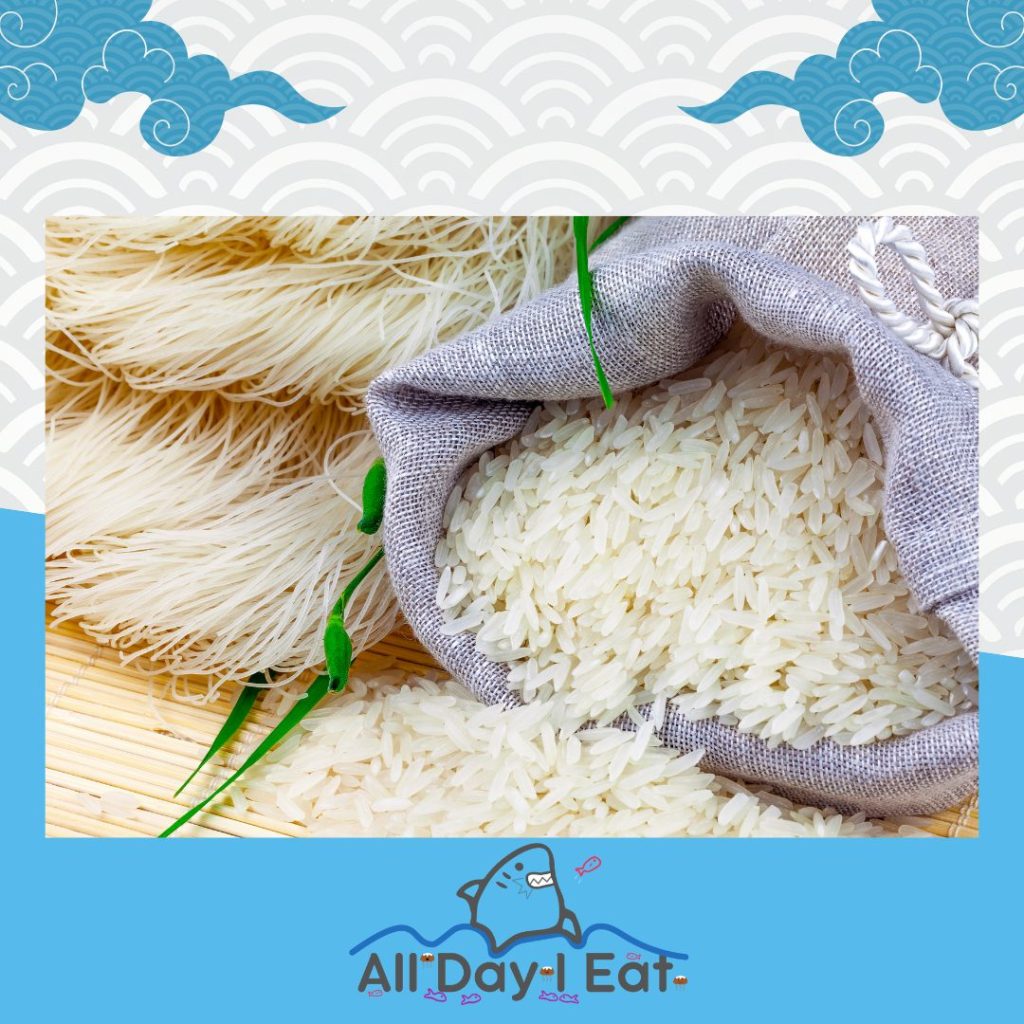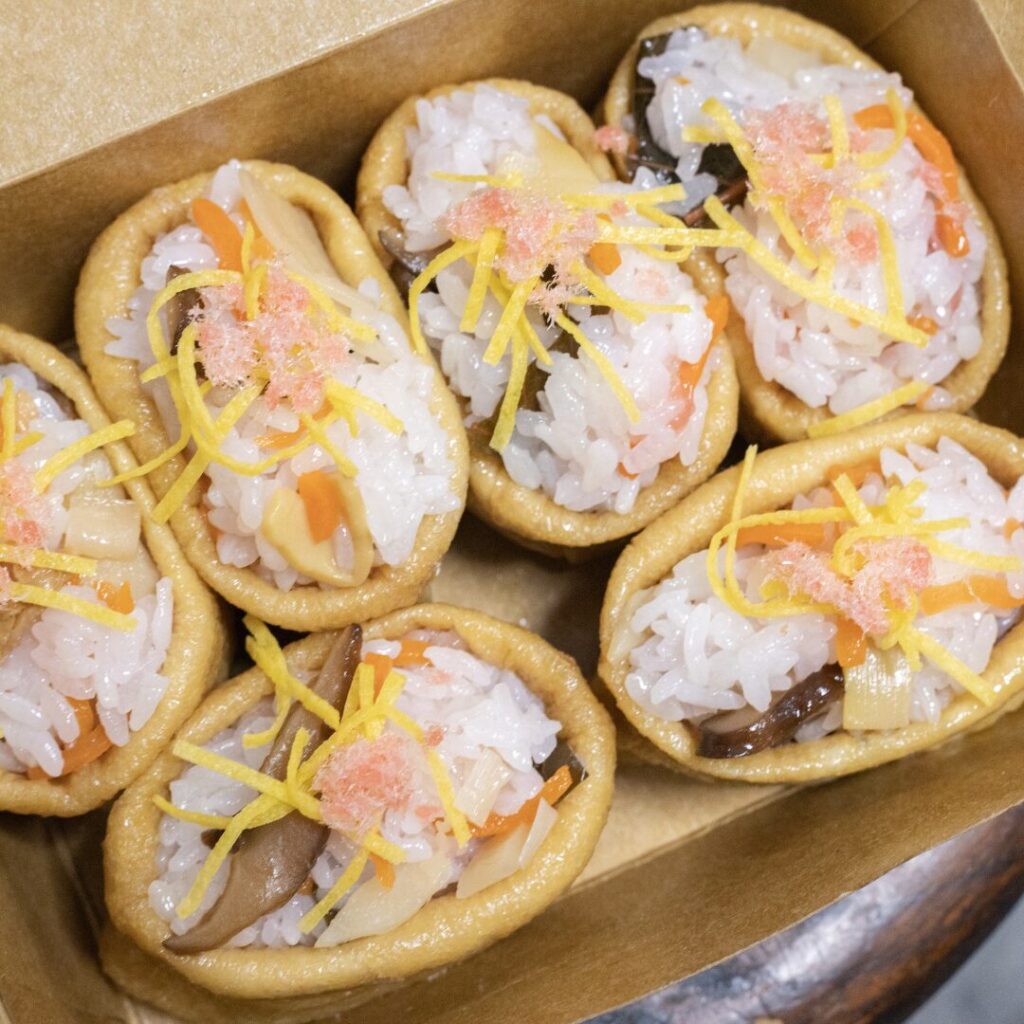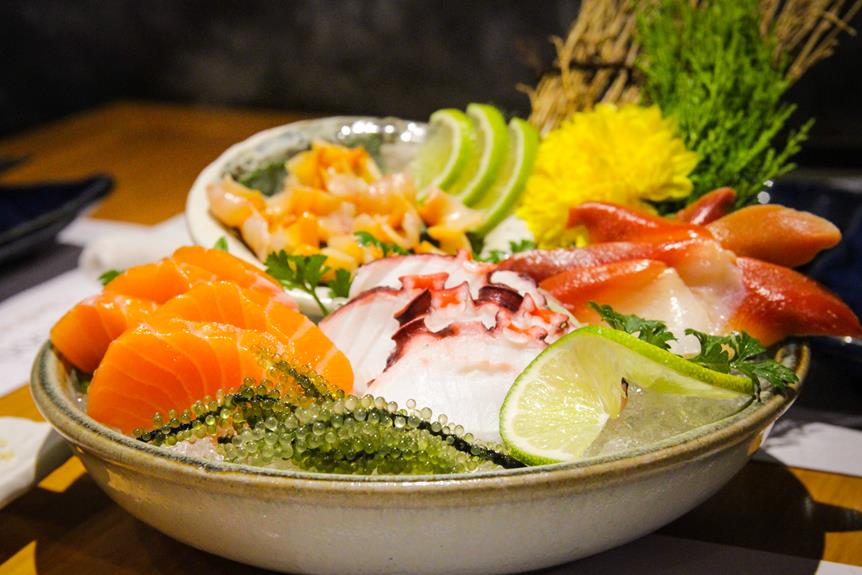Sushi has become a popular dish worldwide, and it’s not hard to see why. The combination of fresh, raw fish, sticky rice, and flavorful vegetables is hard to resist. However, if you’re new to sushi, you may wonder how many pieces of sushi are in a roll. The answer to this question can vary depending on the type of sushi roll you order.


Understanding sushi rolls is important if you want to know how many pieces are in each roll. Sushi rolls are typically made with a layer of rice, seaweed, and a variety of fillings, such as raw fish, avocado, cucumber, and crab. The size and thickness of the roll can affect how many pieces are in each roll. For example, a thin roll like hosomaki usually has six to eight pieces, while a thick roll like futomaki may only have four pieces.
What Is Sushi?

Sushi is a popular Japanese dish that consists of vinegared rice, seafood, vegetables, and sometimes fruits. It is often served with soy sauce, wasabi, and pickled ginger. Sushi is enjoyed worldwide and has become a staple of Japanese cuisine.
There are several different types of sushi, including nigiri, maki, sashimi, temaki, uramaki, and makizushi. Nigiri sushi is a type of sushi that consists of a small ball of rice topped with a slice of raw fish. Maki sushi, a sushi roll, is made by wrapping rice and other ingredients in nori seaweed. Sashimi is a dish that consists of thinly sliced raw fish, often served with soy sauce and wasabi.
Temaki is a type of sushi that is hand-rolled into a cone shape and filled with rice and other ingredients. Uramaki, also known as an inside-out roll, is a type of sushi where the rice is on the outside, and the nori is on the inside. Makizushi is a type of sushi rolled into a cylindrical shape and sliced into bite-sized pieces.
Sushi is a versatile dish that can be enjoyed in many different ways. It can be served as an appetizer, a main course, or a snack. Sushi is often enjoyed with various sauces and condiments, including soy sauce, wasabi, and pickled ginger.
Overall, sushi is a delicious and healthy dish that is enjoyed by people all over the world. Whether you prefer nigiri, maki, sashimi, or any other type of sushi, there will surely be a sushi dish that will satisfy your taste buds.
Understanding Sushi Rolls
Sushi rolls, also known as maki rolls, are a popular type of sushi consisting of rice, seaweed, and various fillings. Sushi rolls come in different shapes, sizes, and types, and the number of pieces in a sushi roll can vary depending on the type and size of the roll.
Types of Sushi Rolls

There are many different types of sushi rolls, each with its unique combination of ingredients. Some popular types of sushi rolls include:
- Hosomaki: thin sushi rolls that typically contain one type of filling, such as cucumber or tuna.
- Futomaki: thick sushi rolls that usually contain multiple fillings, such as egg, cucumber, and pickled daikon.
- California Roll: a sushi roll that typically contains avocado, crab meat, and cucumber.
- Spicy Tuna Roll: a sushi roll that typically contains spicy tuna, cucumber, and sometimes avocado.
- Salmon Roll: a sushi roll that typically contains salmon and cucumber.
- Spider Roll: a sushi roll typically containing soft-shell crab, cucumber, and sometimes avocado.
- Specialty Roll: a type of sushi roll that contains unique ingredients and combinations, such as the Philadelphia Roll (cream cheese and smoked salmon) or the Dragon Roll (eel and avocado).
How Many Pieces in a Sushi Roll?
The number of pieces in a sushi roll can vary depending on the type and size of the roll. Generally, most sushi rolls contain between 6 to 8 pieces. However, smaller rolls like the cucumber roll may have 4 to 6 pieces, while larger rolls like futomaki rolls may have 10 or more pieces.


Hand Roll vs. Sushi Roll
A hand roll, also known as temaki, is a type of sushi rolled into a cone shape and eaten with the hands. Hand rolls typically contain one or two fillings and are made to order. In contrast, sushi rolls are pre-made and cut into pieces before serving.
Ingredients of Sushi Rolls
Sushi rolls are a delicious and popular food item that many people worldwide enjoy. They are made by wrapping a combination of ingredients in nori, a type of seaweed, and rice. The ingredients used in sushi rolls can vary depending on the roll type, but some common ingredients include rice, fish, vegetables, and seaweed.
Rice

Rice is a key ingredient in sushi rolls. It is cooked with vinegar, sugar, and salt to give it a unique flavor and texture. Sushi rice is a short-grain rice that is sticky and holds together well when rolled. It is important to use the right type of rice when making sushi rolls to ensure that they hold together properly.
Fish

Fish is a popular ingredient in sushi rolls. Some common types of fish used in sushi rolls include salmon, tuna, eel, and cooked fish. It is essential to use fresh fish when making sushi rolls to ensure they are safe to eat.
Vegetables

Vegetables are often used in sushi rolls to add flavor and texture. Some common vegetables used in sushi rolls include cucumber, avocado, and pickled ginger. These vegetables add a refreshing crunch to the rolls and help to balance out the flavors.
Nori

Nori is a type of seaweed used to wrap sushi rolls. It is rich in vitamins and minerals and has a unique flavor that complements the other ingredients in the roll. Nori is available in sheets and is easy to work with when making sushi rolls.
Other Ingredients
In addition to the ingredients listed above, sushi rolls can contain other ingredients such as tempura, eggs, sesame seeds, cream cheese, and fruits. These ingredients add flavor and texture to the rolls and can vary depending on the roll being made.
Overall, sushi rolls are delicious and versatile food items that can be customized to suit individual tastes. Using fresh ingredients and the right type of rice, anyone can make delicious sushi rolls at home.
How Many Pieces Are in a Sushi Roll


Sushi rolls are a popular Japanese dish that has been enjoyed by people worldwide. Sushi rolls are made by wrapping vinegared sushi rice and various fillings such as fish, vegetables, and fruits in nori seaweed. One of the most common questions people have about sushi rolls is how many pieces are in a sushi roll.
The number of pieces in a sushi roll can vary depending on the size of the roll and how it has been cut. Generally, a standard sushi roll is cut into six to eight pieces. However, some rolls may be cut into four pieces for larger, more filling portions, while others may be cut into smaller, bite-sized pieces for a lighter snack or appetizer.
It is also important to note that the number of pieces in a sushi roll can vary depending on the type. For example, a California roll is typically made with crab meat, avocado, and cucumber and is cut into six to eight pieces, while a spicy tuna roll is made with spicy tuna and cut into six to eight pieces.
In addition to the standard sushi rolls, other types of sushi can have a different number of pieces. For example, nigiri sushi is a type of sushi that consists of a small ball of sushi rice topped with a slice of raw fish, and it is typically served in pairs. Maki sushi, on the other hand, is a type of sushi made by rolling sushi rice and fillings in nori seaweed, and it can have anywhere from one to twelve pieces depending on the size of the roll and the kind of filling.
In conclusion, the number of pieces in a sushi roll can vary depending on the size of the roll, how it has been cut, and the type of sushi roll. However, a standard sushi roll is generally cut into six to eight pieces.
Nutritional Value of Sushi Rolls

Sushi rolls are a popular Japanese dish that has gained worldwide recognition. They are made up of a combination of ingredients, including seafood, vegetables, and rice, and are often served with soy sauce, wasabi, and pickled ginger.
Caloric Content
The caloric content of sushi rolls can vary greatly depending on the ingredients used and the size of the roll. For example, a shrimp tempura roll can have around 190 calories, while a rainbow roll can have up to 475 calories. It is important to remember that sushi rolls are often served in multiples, so you must monitor the portion sizes you eat to avoid overconsumption of calories.
Fat and Protein
Sushi rolls can be a good source of protein, especially if they contain seafood such as salmon or tuna. However, some sushi rolls can also be high in fat, particularly those that contain fried ingredients such as tempura. Choosing rolls with lean protein sources and limiting those high in fat is recommended.
Sodium Content
Sushi rolls can be high in sodium due to soy sauce and other salty ingredients. For example, a shrimp tempura roll can have up to 330mg of sodium. Therefore, monitor your sodium intake, especially if you have high blood pressure or other health concerns.
Health Benefits
Sushi rolls can provide health benefits, mainly if they contain seafood. Seafood is a good source of omega-3 fatty acids, linked to a range of health benefits, including improved heart health and brain function. Additionally, sushi rolls that contain vegetables can provide a good source of vitamins and minerals.
White Rice and Sugar
Many sushi rolls are made with white rice, which is high in carbohydrates and can cause blood sugar spikes. Additionally, some sushi rolls may contain added sugar, particularly those served with sweet sauces. Monitoring your carbohydrate and sugar intake is essential, especially if you have diabetes or other health concerns.
In summary, sushi rolls can be a healthy and nutritious meal option when consumed in moderation and with attention to ingredient selection and portion sizes.
Potential Health Risks

While sushi can be a healthy and delicious meal, there are some potential health risks you need to consider. Here are a few things to be aware of:
Raw Fish
One of the most significant risks associated with sushi is the potential for foodborne illness from consuming raw fish. Raw fish can contain harmful bacteria, viruses, and parasites that can make you sick. To reduce your risk of illness, it’s important to choose high-quality sushi from reputable restaurants and ensure that the fish has been properly handled and stored.
Mercury
Another potential health risk associated with sushi is mercury exposure. Some types of fish used in sushi, such as tuna, can contain high levels of mercury. Mercury is a toxic metal that can accumulate in the body over time and cause various health problems, including neurological damage.
Heart Disease and Blood Pressure
Sushi can also be high in sodium, contributing to high blood pressure and an increased risk of heart disease. Soy sauce, often used as a dipping sauce for sushi, is particularly high in sodium. To reduce your sodium intake, consider using low-sodium soy sauce or limiting your use of soy sauce altogether.
Weight Gain
Finally, sushi can be high in calories, which can contribute to weight gain if consumed in excess. Some types of sushi, such as those made with fried ingredients or topped with mayonnaise, can be particularly high in calories. To keep your sushi meal healthy and balanced, choose sushi rolls made with fresh, healthy ingredients and limit your intake of high-calorie options.
Overall, sushi can be a healthy and delicious meal option, but you must be aware of the potential health risks and make informed choices about what you eat.
Making and Serving Sushi Rolls

Sushi rolls, also known as maki rolls, are a popular Japanese dish enjoyed worldwide. Making sushi rolls can be fun and rewarding, and serving them can be a great way to impress your guests. This section will cover the basics of making and serving sushi rolls.
Making Sushi Rolls
Making sushi rolls requires a few basic tools, including a bamboo mat, nori seaweed sheets, sushi rice, and fillings of your choice. The fillings can include a variety of ingredients, such as fish, vegetables, and avocado.
To make a sushi roll, start by laying a nori sheet on the bamboo mat. Spread a thin layer of sushi rice over the nori, leaving a small border at the top. Add your desired fillings in a line across the bottom of the rice. Use the bamboo mat to roll the sushi tightly, using the border of rice at the top to seal the roll.
When cutting the sushi roll, it’s essential to use a sharp knife and to wet the blade between cuts. This will help to prevent the rice from sticking to the knife and ensure clean cuts.
Portion Size and Waste
When making sushi rolls, it’s important to consider portion size and waste. A typical sushi roll contains 6-8 pieces, depending on the size and shape of the roll. Thicker rolls will typically contain fewer pieces than thinner ones. When serving sushi rolls, it’s essential to consider the size of your guests’ appetites and to avoid making too much sushi that may go to waste.



Konnichiwa! (Hello!) I'm Pat Tokuyama, a Japanese tofu cookbook author, who travels for music, food, and adventure. If you like Japanese tea, checkout some of the newestorganic japanese tea, matcha bowls and noren and more!
** Curious about the Plant Based Japanese Cooking Club? ** Learn more here!
Serving Sushi Rolls
Sushi rolls are typically served with soy sauce, wasabi, and pickled ginger. Soy sauce is used as a dipping sauce for the sushi, while wasabi and pickled ginger are used as condiments to add flavor to the sushi.
Sushi rolls can be served as a standalone dish or as part of a larger meal. In Japanese restaurants, sushi rolls are often served as part of a bento box, which includes a variety of other dishes such as edamame and sea urchin.
When serving sushi rolls, it’s important to present them in an attractive and appetizing manner. This can be achieved through garnishes such as sliced avocado or sesame seeds. Additionally, serving sushi rolls on a decorative platter can add to its visual appeal.
Ordering and Enjoying Sushi

Sushi is a popular Japanese dish that has gained popularity worldwide. When ordering sushi, it is important to consider the size of the roll and the number of pieces in a roll to ensure you order the right amount for your appetite.
It is recommended that sushi lovers consume sushi rolls in moderation and a healthy amount. The American Heart Association recommends that adults consume at least two servings of fish per week, and sushi can be a great way to meet this recommendation.
When ordering sushi for a party or dinner, it is essential to order enough rolls for everyone. Generally, seven sushi rolls are needed per person for dinner. However, women typically eat six rolls, while men can eat more than eight. If side dishes are provided with the sushi, then fewer rolls will be needed.
Sushi rolls come in different sizes and flavors. Traditionally, most sushi rolls contain between six to eight pieces, but the number may vary depending on the roll’s thickness. Thicker rolls will typically contain fewer pieces than thinner ones.
When enjoying sushi, you should savor each piece and appreciate the full flavor of the roll. Use chopsticks or your hands to pick up the sushi, and dip it in soy sauce if desired. Wasabi and ginger are also common accompaniments to sushi rolls.
In summary, when ordering sushi, consider the size of the roll and the number of pieces, order enough rolls for everyone, and enjoy the full flavor of each piece in moderation.
Conclusion
Sushi rolls are a delicious and popular sushi that comes in many different types and sizes. The number of pieces in a sushi roll can vary depending on the type and size of the roll, with most rolls containing between 6 to 8 pieces. Understanding the different types of sushi rolls and their fillings can help you choose the perfect sushi roll for your taste buds.








Konnichiwa! (Hello!) I'm Pat Tokuyama, a Japanese tofu cookbook author, who travels for music, food, and adventure. If you like Japanese tea, checkout some of the newestorganic japanese tea, matcha bowls and noren and more!
** Curious about the Plant Based Japanese Cooking Club? ** Learn more here!